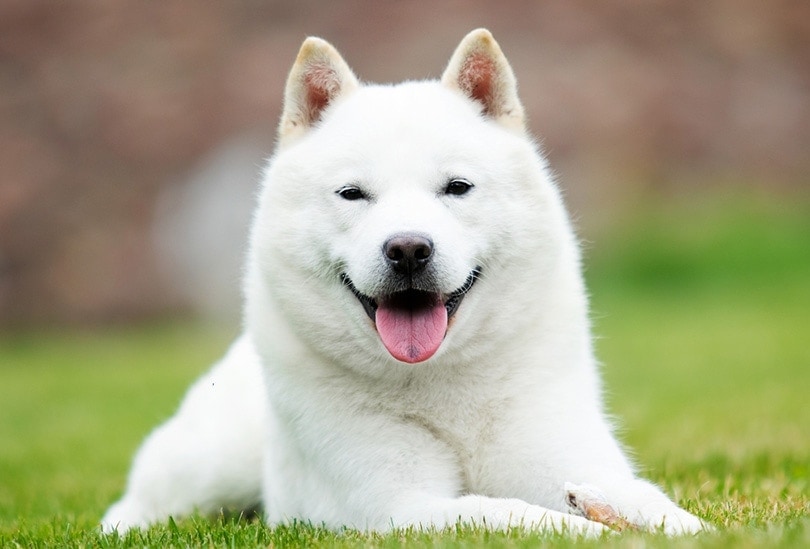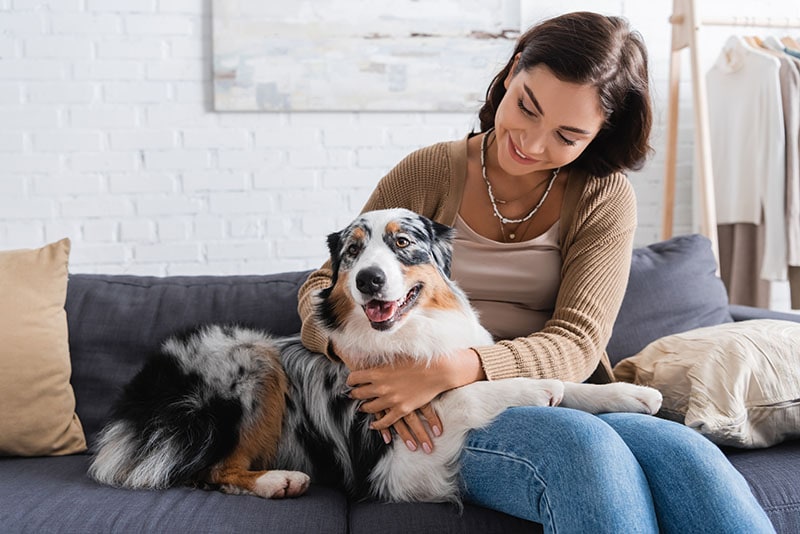Click to Skip Ahead
Dogs communicate through body language rather than spoken words. As such, it can sometimes be tough to understand what they’re saying. Add in the fact that certain behaviors communicate more than one message depending on the context, and it’s no wonder that we sometimes mistake one behavior for another.
Dogs exhibit submissive behavior to tell humans or other dogs that they are not a threat. For dogs, interpreting this behavior and the message that goes with it is intuitive. For humans, this isn’t always the case. We put together this handy list to help you identify and understand the signs that your dog is being submissive.

The 9 Signs of Submissive Behavior in Dogs
1. Lying Belly Up
For dogs, rolling over and lying with their belly exposed is a commonly misread submissive behavior. Many people read this gesture as a request for a belly rub. While this can be true, it often isn’t. Unfortunately, misreading this message can get you snapped at and even bitten by an anxious dog.
Dogs roll over and show their belly as a sign of appeasement and submission. Some dogs like their belly rubbed, but many dogs (particularly anxious and reactive dogs) feel threatened when someone leans over them while they are lying in a vulnerable position. Wolves exhibit this behavior in the wild to communicate to more dominant pack members that they don’t wish to engage in conflict, but it isn’t a signal that they want attention.
If a dog growls or snarls at you while on their back, the message should be clear: The dog is saying, “give me space,” not “rub my belly.”

2. Submissive Urination
Submissive urination or excitement urination is most common in puppies but sometimes continues into adulthood. While it can occur due to overexcitement, it most often happens out of fear, insecurity, or a show of deference to another party.
Most dogs grow out of this behavior on their own, but you can reduce it by boosting your dog’s confidence. Yelling at your dog for submissive urination will only serve to make the problem worse.
3. Looking Away or Avoiding Eye Contact
Direct eye contact is considered threatening to dogs, so they show submission by looking away and avoiding it. This shows that they’re not interested in challenging the other party’s dominance or authority or posing a threat in any way.
If you find your dog staring at you, there are several reasons that they may do this, including affection. While it shouldn’t be considered dominant behavior, dogs that engage in a hard stare accompanied by stiff posture may be resource guarding or sending a message to “stay away.”

4. Flattened Ears
While each dog is an individual, most dogs keep their ears erect when they are relaxed. Floppy-eared dogs don’t show this as well, but looking at the base of the ear can often tell you the position. Deliberate flattening of the ears is meant to send a message of fear, worry, or submission. Looking at the rest of the dog’s body language can help you distinguish which one it is.
5. Lowered Tail
A dog that is wagging its tail while it’s tucked tight against its body is showing submissive behavior. They could be uncertain or fearful of the situation. Tail wagging out of excitement looks different, as the tail is relaxed and high in the air.

6. Getting Low to the Ground
If a dog tries to make themselves smaller by getting down on the ground, it is an effort to appear non-threatening. This is most often a reaction to fear, but not always. Sometimes, adult dogs will do this around puppies to show the youngsters that they don’t mean any harm. It makes them appear less threatening.
7. Licking Lips
Licking of the lips can be a sign of submission or a way for a dog to calm themselves down when they’re feeling anxious. It’s a fear-based reaction but is intended to convey that they don’t want a confrontation.

8. Licking the Muzzle of Another Dog
Dogs have many ways of showing respect to other dogs or communicating to them that they don’t wish to confront them. Licking another dog’s muzzle indicates that they want to encourage the other dog to relax. It’s perfectly normal behavior, whether it’s between two dogs that just met or that live together full time.
9. Grinning or Smiling
Some dogs “smile” with their teeth bared to show submission. This should not be confused with teeth baring originating as aggression. Smiling when the rest of the body is relaxed is often called a “submissive grin.” It indicates approachability and friendliness.
Be careful not to confuse this grin with snarling. Snarling and growling dogs will also bare their canine teeth and have stiff postures and facial expressions. Back away and never approach a snarling dog.


Why Do Dogs Display Submissive Behaviors?
When it comes to dogs, the word “submission” is often misunderstood. While it is technically the opposite of “dominant,” these terms are best avoided. There is a certain hierarchy that occurs within a group of dogs, but old theories regarding dominance and pack mentality have been mostly proven false.
Submissive behaviors are part of a dog’s communication using body language. Since dogs don’t have spoken language, they can’t say, “I’m scared,” or, “Please leave me alone,” so they use body language to communicate those messages. A dog that shows submission is establishing their boundaries in a relationship with a human or other animals. The message is that they are not a threat. Dogs also use these signals to de-escalate situations that they find frightening or tense.
If your dog is showing submissive behavior toward you, it’s usually a sign of respect and love. It shows that your dog is comfortable being vulnerable around you and that they trust you.
It is also important to understand that submission and aggression aren’t mutually exclusive. For anxious or reactive dogs, aggression often comes from fear. When they are fearful, they often exhibit submissive behaviors like exposing their belly to de-escalate the situation. In this instance, the dog is saying, “I’m not a threat; please leave me alone.” If you cross their comfort threshold and persist in approaching or touching them, they may feel they have no choice but to protect themselves with aggression.

How to React to Submissive Behaviors in Dogs
Submissive behaviors can occur as a reaction to perceived danger or as an invitation to play. To interpret what a dog is trying to communicate, you must look at their body language and the context of a situation. Here are a couple of examples.
Your dog meets another dog in an off-leash park. The dog is barking and charging toward your dog. Your dog instantly gets on the ground and rolls over to expose their belly. This is likely an effort to show that they don’t pose a threat to the barking dog and a reaction to a fearful situation. It also sends the message to “stay away.”
In the same park, your dog meets another friendly dog. They sniff each other’s rear ends to say hello. Then, your dog lowers themselves low to the ground and looks away from the other dog. Most likely, your dog is inviting the other dog to play. This submissive behavior is often followed by a play bow. It says, “I like you and want to play.”
If your dog shows you submission, it means they see you as an authority figure and want to show you respect. There’s no need to alter your behavior toward your dog. However, if your dog is fearful of you then you need to work on improving the relationship.

Final Thoughts
In general, dogs show submissive behavior to indicate that they are not a threat. Since some of these behaviors can be fear-based, it’s important to read the context of the situation and your dog’s overall posture to avoid unwanted reactions. If your dog regularly acts submissive toward you, this is normal and nothing to worry about. It’s a sign that your dog loves and respects you.
Featured Image Credit: Neelsky, Shutterstock









